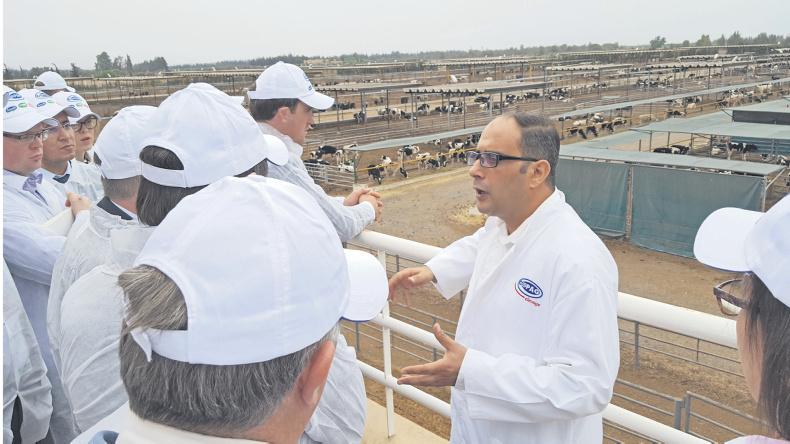When spending some time travelling the highways of Morocco, you see an eclectic variety of activity. You see tractors, old and new, with just a roll-over bar and a fibreglass top to shade you from the sun.
You see Mercedes cars from the 1980s with taxi signs on the roof, beggars walking through rush-hour traffic and goats grazing scrub on the outskirts of towns. From the sky, you see vast tracts of land with nothing but a few trees scattered here and there and random fields of vegetables covered in netting.
It is vastly different to Ireland, but it is evident that there are opportunities there. Given its proximity to us and its growth, it presents an opportunity for Irish exports of livestock and milk powder.
Agri-food exports from Ireland to Morocco have almost doubled from €8m in 2013 to €14.5m in 2015.
Shipments of dairy produce to Morocco by the end of July 2016 (3,650t) had already outstripped the entire volume of produce that was exported there in 2015.
The country is experiencing strong growth and those who have been there before said that they noticed a huge difference even in the last five years, with far less poverty visible now.
GDP growth is estimated at 3.7% for 2016, with general improvements on income levels and an annual population growth of 1.4%.
Figures from Bord Bia show that demand for all categories within the dairy sector is growing between 2% and 4%.
Watch a video of the recent Irish trade mission to Algeria and Morocco below:
On the first day of the trade mission to Morocco, Minister for Agriculture Michael Creed met with his counterpart there to “forge links at a political level”.
He also had meetings with the relevant agencies, such as the Moroccan agricultural development association and the scientific and veterinary sections.
“I’m very conscious that on a trade mission business is done business to business.
“The value of this trade trip will probably be something we can measure this time 12 months. But I think there is business to be done here.”
In light of Brexit, “we have to look for all the market opportunities that we can. North Africa traditionally has been important. Some produce is subject to tariff, as I understand it breeding cattle are not.”
Green Morocco
Not unlike Ireland’s Food Harvest 2020 plan, Morocco has a strategy since 2008 called the Green Morocco Plan. Among other things, it aims to increase production and consumption of dairy and meat. Figures presented to the Irish delegation visiting Morocco showed that red meat production meets 98% of consumption levels.
However, the Green Morocco Plan aims to increase consumption levels from 14.2kg/capita in 2013 to 17.3kg/capita by 2020. Alongside this, the plan is to increase production of red meat from 490,000t to 612,000t over the same period. Given the fact that 67% of farms have less than three cows, it would seem that the only way is up.
Moroccan officials at the ministry for agriculture asked the Irish delegation how they encourage consumption of meat. It is clear that price is a limiting factor, as consumers there opt for cheaper sources of protein.
In line with the plan to increase milk production, Morocco has no tariff for importing pregnant heifers. Heifers for breeding purposes that are not in-calf are subject to a 2.5% tariff. The preference is for animals able to produce 5,500l in the first lactation.
But live import of beef animals is subject to a 25% tariff and carcases are subject to a 200% tariff. The country has only imported around 10,000hd/year in the last six years, so it is unsurprising that Spain and France fill a large proportion of that, given their proximity and lower transport costs.
The cost of sending small numbers of animals that are subject to high tariffs seems to outweigh the benefits of sending animals there.
Any sort of collaboration on live exports between Ireland and Morocco would have to be a long-term partnership that would benefit both countries.
The mission created that platform for Moroccan officials to seek expertise that Ireland has built up in relation to its agricultural industry.
David Butler from Sustainable Food Systems Ireland (SFSI) met with political representatives there to see how a partnership-type approach could be developed between the two countries.
“With the countries we trade with, this is strongly in demand. Ireland has put in place the technologies and systems and is highly regarded in that area,” Butler said.
“Where our experience is particularly strong is in technologies in certain sectoral areas. So, for instance, in the whole livestock area in terms of improving genetic merit.”
Dairy
However, on the dairy side, Morocco is importing some milk powder and cheese from Ireland. Business meetings and visits in the Moroccan dairy sector as part of the trade mission included Copralim, the country’s largest importer of dairy products.
Figures presented on a tour of the cheese-processing facility show that Copralim imports milk powder, butter and cheddar from Ireland.
It has increased the volume of produce it has bought in Ireland in recent years, which purchasing manager Abdelaziz Lamhaimer explains is part of the overall growth strategy for the company.
“The consumption of cheese is increasing day after day in Morocco. Not only this, but also our brand has become one of the best brands in the Moroccan market in processed cheese,” Lamhaimer said in an interview with the Irish Farmers Journal.
When purchasing ingredients, he said “the most important factor is quality, sustainability. That’s why we focus on importing our raw material from Ireland because, for our production managers Irish products are rich in proteins. We are always told by our people to try to import either Irish product, Australian product or other specific origins.”







 This is a subscriber-only article
This is a subscriber-only article










SHARING OPTIONS: